PEARL HARBORRemember

A PACIFIC HISTORIC PARKS PUBLICATION FALL 2022
Board of Directors
Alan Mattson, Chairman
Jeff Bell, Vice Chairman
Alma M. Grocki, Secretary
Clif Purkiser, Treasurer
James M. Boersema
Noel W. Bragg
Alma M. Grocki
Patricia A. Lucas

Edward J. Lynch
MISSION STATEMENT
Board of Directors (cont.)
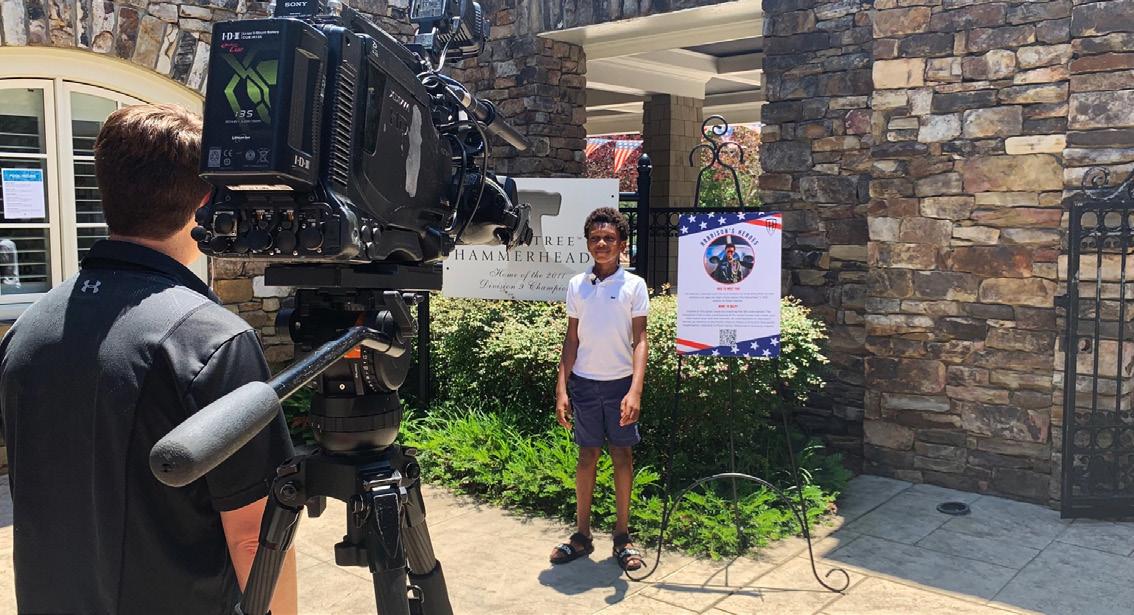
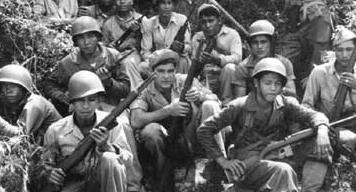
Mark Y. Matsunaga

Dr. Ed Noh Michael Olson Theodore Peck Alby L. Saunders Mathew Sgan Agnes T. Tauyan

CONTENTS 3 President’s Message 4 Preserving World War II History 8 Wartime Impacts Everyday People 9 Harrison’s Heroes 10 The Guam Combat Patrol 12 Kalaupapa Ohana Lives On 13 Prayer for the Dead 14 You Make It Happen! 4 8 9 10 FALL 2023 98-211 Pali Momi Street #200-A Aiea, Hawaii 96701 www.pacifichistoricparks.org (888) 485-1941
To support the USS Arizona Memorial and other Pacific historic locations through education and interpretive programs, research, preservation, and restoration, to perpetuate the
of events and honor the people
in these sites. Remembrance is published four times a year as a benefit to Friends of Pacific Historic Parks. Cover Photo Courtesy Pearl Harbor National Memorial
memory
involved
President & CEO Aileen Utterdyke
2 REMEMBRANCE FALL 2022
Directors Emeritus Neil A. Sheehan Geoffrey M. White Joachim P. Cox, Legal Advisor Publication Advisers Aileen Utterdyke Edean Saito Editor Jim McCoy Layout & Design Chase Nuuhiwa
PRESIDENT & CEO MESSAGE
Our cover story begins with suggestions on how we can collectively keep their stories alive so future generations will never forget them.
We interviewed a Vietnam veteran who lost an uncle in the Pearl Harbor attack. We spoke to a Washington State man whose uncle survived World War II but was killed in a North Korean POW camp. We interviewed a member of a Hawaii family who just lost their 100-year-old mother. She died just months after learning she became a member of the American Rosie The Riveter Association for a job she held in Hilo during the war.
This edition also has a profile on nine-year-old Harrison Johnson and his campaign to raise funds to support efforts to memorialize Pearl Harbor.
He’s just read a book authored by one of the most prominent survivors of the attack.
From Guam, we have two stories. One profiles a group called the Guam Combat Patrol that was formed following the American liberation of Guam. Their job was to capture fugitive Japanese forces hiding out in the jungles. The second story focuses on how the lives of ordinary people were affected by the war.
From Kalaupapa, we have the story of Veteran gravestones in the Papaloa Cemetery who were patients of the settlement.
In case you missed our monthly newsletter, here’s the latest on the upcoming 81st Commemoration of the attack on Pearl Harbor. This year’s theme is “Everlasting Legacy” reflecting the importance of remembering Pearl Harbor and the sacrifices made by 16 million Americans who served in the war along with those who worked on the home front.
We are pleased that unlike the past two years, this year’s Commemoration will not have any COVID attendance restrictions in place at the Pearl Harbor National Memorial. We will have more on the commemoration events on our website and social media posts in the coming week, so come take a look.
As always, thank you for being a member of Pacific Historic Parks. Your donations are vital to meet our mission to never forget Pearl Harbor, and to Remember, Honor and Understand World War II in the Pacific.
AILEEN UTTERDYKE President & CEO

A copy of the latest financial report, registration filed by this organization, and a description of our programs and activities may be obtained by contacting us at: 94-1187 Ka Uka Blvd., Waipahu, HI 96797, (808) 954-8777. Pacific Historic Parks was formed in Hawaii. If you are a resident of one of the following states, you may obtain financial information directly from the state agency:
Florida: A COPY OF THE OFFICIAL REGISTRATION AND FINANCIAL INFORMATION MAY BE OBTAINED FROM THE DIVISION OF CONSUMER SERVICES BY CALLING TOLL-FREE, WITHIN THE STATE, 1-800-435-7352 (800-HELP-FLA), OR VISITING www.FloridaConsumerHelp.com. REGISTRATION DOES NOT IMPLY ENDORSEMENT, APPROVAL, OR RECOMMENDATION BY THE STATE. Florida Registration #CH17306 Georgia: A full and fair description of our programs and our financial statement summary is available upon request at our office and phone number indicated above. Maryland: For the cost of copies and postage, from the Office of the Secretary of State, State House, Annapolis, MD 21401. Mississippi: The official registration and financial information of Pacific Historic Parks may be obtained from the Mississippi Secretary of State's office by calling 1-888-236-6167. Registration by the Secretary of State does not imply endorsement. Nevada: Contributions may be tax deductible pursuant to the provisions of sec. 170(c) of the Internal Revenue Code of 1986, 26 U.S.C. ¤170(c). New Jersey: INFORMATION FILED WITH THE ATTORNEY GENERAL CONCERNING THIS CHARITABLE SOLICITATION AND THE PERCENTAGE OF CONTRIBUTIONS RECEIVED BY THE CHARITY DURING THE LAST REPORTING PERIOD THAT WERE DEDICATED TO THE CHARITABLE PURPOSE MAY BE OBTAINED FROM THE ATTORNEY GENERAL OF THE STATE OF NEW JERSEY BY CALLING (973) 504-6215 AND IS AVAILABLE ON THE INTERNET AT www.state.nj.us/lps/ca/charfrm.htm. REGISTRATION WITH THE ATTORNEY GENERAL DOES NOT IMPLY ENDORSEMENT. New York: Upon request, from the Attorney General Charities Bureau, 120 Broadway, New York, NY 10271. North Carolina: Financial information about this organization and a copy of its license are available from the State Solicitation Licensing Branch at 1-919-814-5400. The license is not an endorsement by the state. Pennsylvania: The official registration and financial information of Pacific Historic Parks may be obtained from the Pennsylvania Department of State by calling toll-free, within Pennsylvania, 1-800-732-0999. Virginia: From the State Office of Consumer Affairs in the Department of Agriculture and Consumer Affairs, P.O. Box 1163, Richmond, VA 23218. Washington: From the Secretary of State at 1-800-332-4483 or http://www.sos.wa.gov/charities/ West Virginia: West Virginia residents may obtain a summary of the registration and financial documents from the Secretary of State, State Capitol, Charleston, WV 25305. Wisconsin: A financial statement of the charitable organization disclosing assets, liabilities, fund balances, revenue and expenses for the preceding fiscal year will be provided to any person upon request. REGISTRATION WITH A STATE AGENCY DOES NOT CONSTITUTE OR IMPLY ENDORSEMENT, APPROVAL OR RECOMMENDATION BY THAT STATE. More information about charity state disclosures and charitable solicitation registrations.
This edition of Remembrance is dedicated to the quickly dwindling members of our Greatest Generation. We must never forget their sacrifices.
WWW.PACIFICHISTORICPARKS.ORG 3
THE IMPORTANCE OF PRESERVING

WORLD WAR
II
HISTORY
By Jim McCoy, Pacific Historic Parks
4 REMEMBRANCE FALL 2022
“Everlasting Legacy” is the theme for the upcoming 81st Commemoration of the attack on Pearl Harbor that triggered America’s entry in World War II.

It’s acknowledging the sad reality that members of our Greatest Generation are slipping away while also shining a light on the importance of documenting their stories for future generations.
So what steps should we take to honor the World War II survivors along with those who worked on the home front supporting the war effort? Here’s some advice on how to achieve everlasting legacy for the Greatest Generation.
Raymond Emil Kapaun is a sales engineer in Washington State. His middle name is in honor of his uncle, U.S. Army Capt. Emil Joseph Kapaun, a Catholic priest who served in the latter stages of World War II and died in 1951 at a North Korean POW camp. His family spent heart wrenching decades not knowing where his remains were.
“I was born years after he died but I knew the stories and anytime you talk about him it gets me emotional and I can thank my grandmother for that more than anything,” Kapaun said
When Father Emil’s fellow POWs were released from custody, they told stories of how he helped them stay physically and spiritually strong. In 1956 a school in Kansas was named after him.
Fast forward more than half a century to 2013 when President Barack Obama posthumously awarded Father Emil the Medal of Honor. His nephew Ray was on hand to receive it. Most of his relatives had long passed.
Years later remains of unknowns from the Korean War were dug up at the National Memorial Cemetery of the Pacific in Hawaii. In 2021, Father Emil’s remains were identified by the Defense POW/MIA Accounting Agency and returned to his home parish near Wichita, Kansas.
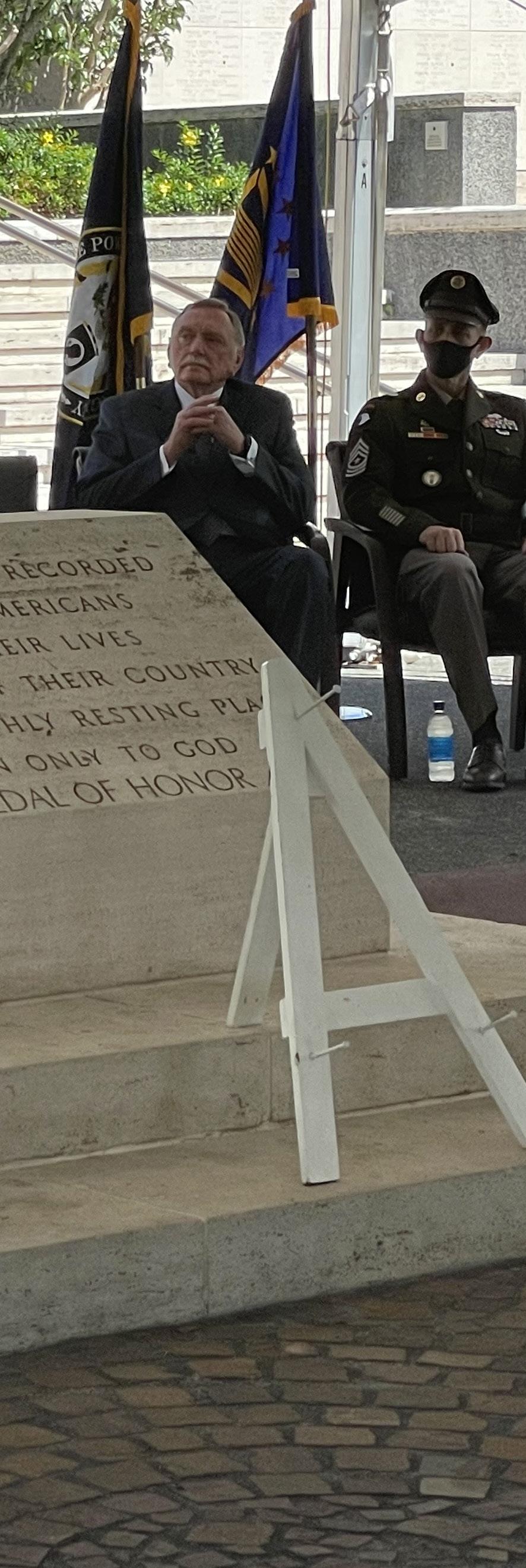
WWW.PACIFICHISTORICPARKS.ORG 5
Ray Kapaun at the POW/MIA Recognition Day at Punchbowl
During a keynote speech at the National POW/MIA Recognition Day at Punchbowl September 16, Kapaun credited his grandmother with keeping the story of his uncle front and center.

“Even when she had Alzheimer’s she didn’t remember my name and barely knew Dad’s name, but she would always ask my Dad if Emil would ever come back home. And I remember Dad would always hang his head and have to tell her that he didn’t think he would,” Kapaun said.
Retired Army Colonel John Knight made CDs for his family members so they know about the death of an uncle killed on the USS Arizona December 7, 1941. Electricians Mate Third Class Robert Wagner Knight was just 19. His remains are entombed in the battleship with roughly 1,000 fellow crewmembers killed on that day of infamy. The CDs also have information on John and his brother Roger Knight’s service in Vietnam.
The Knight family had another family member who served and survived World War II but wasn’t aware his service included hot spots in North Africa and India. That was discovered decades after his death in 1970.

“Often times you don’t know what you don’t know, so ask the question and in doing so people get the appreciation for the old quote that ‘history is’ and not ‘history was’,” Knight said. “And then you get a sense of continuity in terms of family and ancestry and service and that can be a guidepost for future generations.”
On September 13, 2022, Ella Fujie of Honolulu died at the age of 100. According to her family she passed “peacefully and elegantly” and had a steady stream of visitors the past several months.

She had many accomplishments in her life profiled in a recent interview on PBS Hawaii. The latest honor was membership in the American Rosie the Riveter Association for her work at the Army PX in the Hilo Armory during World War II.
Jan Davis’s mother was a Rosie. A year ago, Davis was asked to start a Rosie chapter in Hawaii. Ella was the first Hawaii Rosie she and Pat Ferraris found. When they interviewed her in May, Ella “lit up” about her Hilo work during the war. She was awarded the certificate before she died.
Veterans of the Korean War pay tribute at Punchbowl
Capt. Emil Joseph Kapaun
Knight family members experience the VRs at Pearl Harbor
6 REMEMBRANCE FALL 2022
“We are so happy to have found Ella and to have had this brief but spectacular encounter with her,” Davis said.
“Everyone was thrilled for the recognition and we’re just proud of our mother,” Ella’s son Richard Fujie said. “She was really open minded and not afraid to do things like traveling by herself to the East Coast back in 1961.”
Fujie suggests that families record the stories of greatest generation members. “There’s very few of them left. Sometimes the experiences they had in the past were not good ones and don’t want to speak about it, but sometimes when they get older, they are willing to express themselves so it’s good to ask again.”


Tammy Brumley, known as the Rosie Wrangler for her work at Rosie the Riveter World War II Home Front National Historical Park in California, recalled that even one of her family members didn’t know she was a Rosie.

“Her son finally asked her well mom, weren’t you a Rosie and she said no, I didn’t rivet. And it turned out she had painted bombs at a munitions factory in Arkansas and so she thought she had to be a riveter and there are a lot of women out there that still have that misconception,” Brumley said. “If you worked for the war effort on the home front, you are a Rosie.”
At the dinner table and other family gatherings consider taking the steps that others have followed: Ask questions, listen, research and record.
There will come a time when Pearl Harbor commemorations won’t have the physical presence of aging World War II veterans , Rosies and other home front workers. But they will include the recorded testimonials about the attack that changed the world and a war that saved our democracy.
Ella (Minaai) Fujie, on right, with older sister Sadako Minaai at the family home in Hilo in 1942
Ella's love for travel and celebrating her 100th birthday with Grandchildren Photos courtesy Fujie Family
WWW.PACIFICHISTORICPARKS.ORG 7
Chronicling the Stories of
ORDINARY PEOPLE IN EXTRAORDINARY WARTIME
By Jillette Leon-Guererro
While learning about the stories of my father’s experiences during World War II, I realized that many of the “ordinary” people he described exhibited exceptional strength, courage, and fortitude yet many of their stories are unknown.

On December 8th, 1941, my grandmother [Nana], Vicenta Ada Torre Leon-Guerrero, was at home preparing for a feast celebrating Santa Marian Kamalen, the patron saint of Guam.

After the Japanese started bombing, Nana had to gather her seven children – the youngest just a few months old – to prepare to leave their home in Agana [Hagåtña].
“When is the truck coming? Her son asked. “I don’t know,” Nana said, “you should thank God that we are safe, and your father and Juan are safe at the ranch.”
She had been carrying the baby all day. Dolores, her eldest daughter, took baby Jose to give her a rest. Nana sat on a log and looked up at the sky. Suddenly she got up and walked to the center of the road looking at the sun. She stopped and then looked at her shadow. She did this again, three times.
‘It’s about 1:30 p.m.,” she announced. We should be walking. We might make the ranch before dark. Let’s get going!”
They walked five miles before someone picked them up. Her calm, matter-of-fact way of handling the situation would see her through the war. It didn’t matter that she had seven children to care for; she didn’t complain and just got on with what was needed. The war would test her time and time again and yet she rose to every occasion. She nursed her eldest son, Juan after he had been tortured for helping an American pilot after his plane crash-landed near their property.

Before he was fully healed, he was taken to work repairing the runway that was constantly being bombed by the Americans. It wasn’t long before they received word that he was very ill. It was then that his father, Ignacio came up with a plan to rescue him from the Japanese work camp. With his best cow, Ignacio moved through the jungle unseen from Machananao to Tiyan where the airstrip was. With the help of a Chamorro in the camp, he was able to time the rescue when the sentry guards were taking a break. They loaded Juan onto the cow and made their way back to the ranch. Nana nursed him back to health using medicinal herbs. Realizing that he wouldn’t be safe, they kept him hidden for the rest of the war.
So many wartime stories are about great heroism, combat, and tragedy, most often told by those in civic life. But what of the stories of ordinary people in extraordinary times? Their stories also have significant value. I am one of a grateful line of descendants that recognize the sacrifices my grandparents made in ensuring our family survived. Through dad’s stories, I recognize that their faith in God, love of family, strength, character, and courage saw them through the dark days of World War II.*
*Funding has been provided to Pacific Historic Parks from Humanities Guåhan and the National Endowment for the Humanities (NEH) as part of the federal ARP Act of 2021.*
Ignacio Fejerang Leon Guerro
8 REMEMBRANCE FALL 2022
Vicenta Ada Torre Leon Guerrero
HARRISON’S HEROES
By Rebecca Schwab
Giving up a Memorial Day weekend vacation to Cancun, Mexico might upset a lot of people, but not fourth-grader Harrison Johnson.
“I asked my parents to cancel it,” he said, “[so I could] man my booth.”

That booth was for his fundraising effort, Harrison’s Heroes, at the Hasentree Country Club’s Memorial Day celebration in his home state of North Carolina. Harrison may only be 9-years-old, but his sights are set on a serious goal: to raise $100,000 through Harrison’s Heroes for Pacific Historic Parks, in support of the Pearl Harbor National Memorial.
Harrison, who loves to rock climb, swim, and play golf, had never done a fundraiser before. His idea for Harrison’s Heroes all started with a third-grade history project.
“I had to pick a US landmark,” Harrison said. “I chose the Pearl Harbor National Memorial because back then I didn’t really know what it was, I didn’t know what happened there, [or] why it was a memorial.”
The things he learned while doing his school project intrigued him so much that he wanted to see Pearl Harbor for himself. In the spring of 2022, Harrison

traveled with his family to Oahu, Hawaii to visit the memorial, an experience he said inspired him to start fundraising in support of the site.
“I was there, and the thought just came to me,” Harrison said. “It’s important so that people my age can learn about the heroes of the Pearl Harbor attack.”
One of those heroes, he said, is USS Arizona survivor Lou Conter. Conter was a 20-year-old sailor from Colorado who was on the quarterdeck of the USS Arizona on the morning of December 7, 1941. After a bomb hit and caused a massive explosion in the forward part of the ship, Conter helped other wounded menpulling many out of the fire - until he heard the sound to abandon ship.
“I read his book,” Harrison said. “I thought it was a great book. People my age think heroes come from comic books and movies, but my heroes are the people who served in the Pearl Harbor attack.”
It’s stories like these that Harrison wants to make sure his generation hears. That’s why he’s leaving no stone unturned in his effort to raise funds - from golf tournaments, to restaurants like Chipotle and Panera, to knocking door-to-door.
“I sometimes go house to house, going out with my cards, which say a little about myself and Harrison’s Heroes,” he said.
Harrison’s mother, Cheznee Johnson, said that at first she was a little unsure about the amount of money he wanted to raise.
“There was hesitation on my part,” she said with a laugh. “ But he was pretty firm. That was the amount. This might be a long road, but … he’s not going to stop until he reaches that goal, even if it’s a multi-year effort. We’re so proud and we hope it makes the impact that he intends.”
So what would Harrison like to see Pacific Historic Parks do with the funds?
“I hope they might make a display to show the heroes of the Pearl Harbor National Memorial to children,” Harrison said.
As of September 20th, Harrison’s Heroes has received $11,420 in donations. To find out more about Harrison’s Heroes and to donate, go to www.pacifichistoricparks. org and click on “ways to give.”
WWW.PACIFICHISTORICPARKS.ORG 9
SECURING THEIR ISLAND:
By Father Eric Forbes

The Chamorros of Guam could not, by themselves, expel the Japanese occupying forces in the last days of the war in July of 1944, but they did participate in consolidating that victory over Japanese rule once American forces did return to the island. The Guam Combat Patrol was formed in November of 1944, just three months after the American recapture of Guam, for the purpose of capturing fugitive Japanese soldiers hiding in the island’s thick jungles.



Guam may have fallen back into American hands in August of 1944, but that didn’t mean the total elimination of the Japanese threat to Chamorro and American lives just yet. Hundreds of fearful Japanese soldiers refused to surrender and, instead, fled into the jungles to avoid capture. It was considered by the Japanese military a tremendous dishonor to surrender to the enemy and be killed, so they believed, by their hands. If the Japanese soldier were to die, they preferred to be masters of their own deaths.
The Japanese hideouts took refuge in caves, ravines and gullies. Most still had their guns and grenades, and many were not hesitant to shoot at American and Chamorro targets when they thought it was advantageous to do so. Since the jungle afforded meager resources, the Japanese stragglers would raid Chamorro ranches or American depots under cover of night, taking what they could.
THE GUAM COMBAT PATROL
10 REMEMBRANCE FALL 2022
American soldiers were being eliminated one at a time, and Chamorro ranchers complained of missing livestock, all due to these Japanese runaways.
The Guam Combat Patrol was formed to respond to these concerns, by assisting in the capture of the remnants of Japanese forces taking cover in Guam’s hinterland. It consisted at first of fifteen members of the civilian Guam Police, especially assigned to this specific task of rounding up Japanese stragglers. “We were manhunters,” said one of the members many years later. The group grew to twenty-some members and was later attached to the US Marine Corps.
Sightings of Japanese hideouts and evidence of their night stalking were already available, but the Guam Combat Patrol actively looked for the Japanese, exposing themselves to the risk of an attack. In one instance, members of the Patrol found a shack on a rocky cliffside, only to be fired on by Japanese soldiers waiting in hiding. Antonio P. Manibusan got hit in the chest right into the heart and died instantly. The other Chamorro patrolmen had to flee the barrage of Japanese gunfire. When they came back the next day to retrieve Manibusan’s body, they saw that his face had been smashed in by the butts of Japanese rifles. Other patrolmen also died or were wounded in the service.

Under the leadership of Staff Sergeant Juan Unpingco Aguon, the Guam Combat Patrol combed every nook and cranny of the thirty-mile-long island. There was not a tunnel, cave or ravine
not thoroughly checked-out by the Chamorro patrolmen. The Patrol broke down into two platoons of seven men each, with a sergeant leading each platoon. A point man walked ahead of the platoon, looking for signs of Japanese activity.
As time wore on, the Japanese stragglers succumbed to the difficult conditions of the jungle. Their rifles jammed; their grenades never exploded. Hungry and tired, they began to look more like beggars than soldiers, and the Chamorro patrolmen started to pity them more than fear them. By 1948, the Patrol had done its job. One hundred and seventeen Japanese fugitives had been killed and five captured. Even though a few more Japanese soldiers lived on undetected, the threat was so minimized that the Guam Combat Patrol ceased operations that year.
Every member of the Guam Combat Patrol received the Bronze Star. In 1970, those members still living, or their widows, received $2500 from the Government of Guam in recognition of their service. One patrolman said, “I take pride in saving lives, defending and serving the people of Guam, and for still being alive.” The Patrol allowed some Chamorro men to have a part in the liberation of their homeland from an occupying force they did not want.
*Funding has been provided to Pacific Historic Parks from Humanities Guåhan and the National Endowment for the Humanities (NEH) as part of the federal ARP Act of 2021.*
WWW.PACIFICHISTORICPARKS.ORG 11
OUR KALAUPAPA OHANA LIVES ON
By Sister Alicia Damien Lau
That was the headline of a two-page newspaper ad penned by Queen Lili’uokalani and Prince Jonah Kuhio Kalaniana’ole in 1917.
Hawaii may have been remote from the beginning of World War I in June 1914, but residents felt compassion for all victims of the war. The Territory contributed generously to war relief efforts.
In a broadcast of the Hawaii Public Radio, Ryan Finnerty said: “Despite being annexed by the United States only 19 years earlier, people in Hawaii embraced the war effort. Thousands volunteered for service in the military and on the home front. Queen Lili’uokalani led a territorywide drive to knit wool socks and bandages. The largest mobilization of the Hawaii National Guard in history was called. By the end of fighting in 1918, more than 100 people from Hawaii had been killed in The Great War.”
Walking through the Papaloa Cemetery in Kalaupapa, Michael Hobbs, NPS, found a number of Veteran gravestones who were patients. On November 11, 2014, the Kalaupapa National Historical Park Facebook listed 25 names of those patients who had served in the armed forces, dating to World War I, and one kokua (helper), Ira Barnes (Joseph) Dutton from the Civil War.



Of the 26 names and pictures on the gravestones, one in particular called to me. Harold S. Weight. He was born in Papaikou on September 28, 1890, enlisted on March 29, 1915, and was stationed on the USS Maryland. According to the records his granddaughter-nurse Debbie Collard here in Kalaupapa shared, he belonged to the US Marine Corps, unit 4th REG, Company 26th. On March 31, 1919, he was discharged and returned after the war on May 18, 1919, on the ship Niagara at the age of 29. Six years later, on June 19, 1925, a picture of him was taken at the Kalihi Hospital and he was sent to Kalaupapa.
This summer, Debbie spent three weeks on the Island of Hawaii with her family. She met for the first time her cousin Michael Weight. Michael’s father was Harold’s brother. The family never knew Harold was sent to Kalaupapa. Three of Harold Weight’s great, great grandchildren (Makenna, Markus and Marciam Watt) spent several days in Kalaupapa with their grandmother, learning about their ohana. Their great grandmother was born in Kalaupapa as were some of their aunts and uncles
Harold S. Weight will be remembered for years to come. This moment in time will be in their minds as an awareness of their time with their grandmother, experiencing Kalaupapa, and learning about the past and present..
12 REMEMBRANCE FALL 2022
“No True Hawaiian Will Evade It.”
Prayer for the Dead
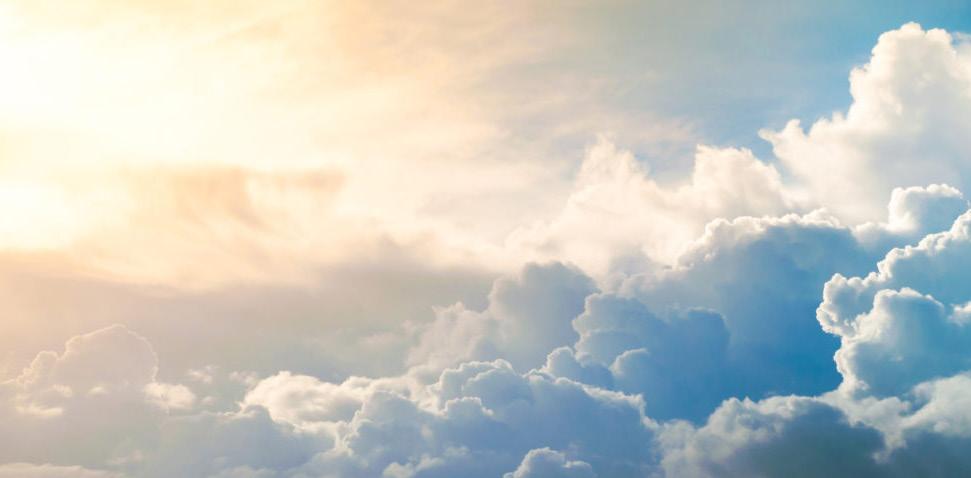
Heinz Bachman
Hickam Field San Antonio, TX
Roy S. “Swede” Boreen
USS Oklahoma Pinehurst, NC

Richard “Dick” Henry
USS Helena Fernandina Bch, FL
Charles Kelley Jr.
USS Helena Zion, IL
Thomas S. “Ace” Nelson
USS Wasmuth Ilion, NY
Kenneth “KP” Platt
Schofield Barracks San Antonio, TX
Francis Paul Riley
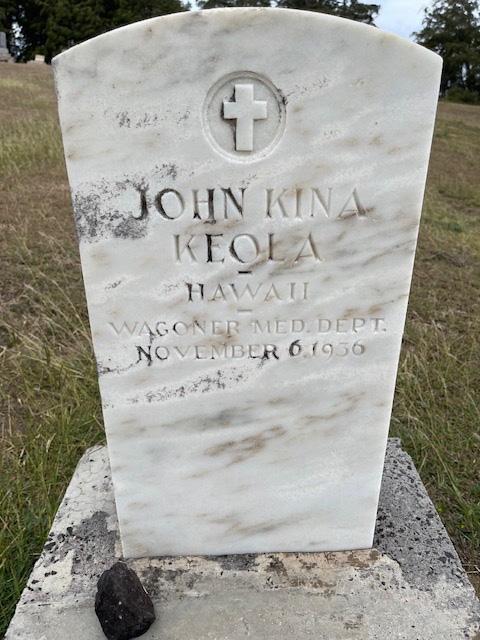
USS Vestal Cedar Rapids, IO

Cecil F. Wigmore Fort Shafter Holiday, FL
Richard O. Young Sr. USS Worden Harrisonburg, VA


“Eternal rest grant unto them and let perpetual light shine upon them and may they rest in peace.”
WWW.PACIFICHISTORICPARKS.ORG 13
Harold Weight served four years as a Marine in World War I. Six years after he left the service he was taken to Kalihi Hospital and then Kalaupapa. Photos courtesy Sister Alicia Damien Lau and Michael Hobbs
HONOR OF

Your contributions help us
our mission to ensure that the
the
II are
We would like to recognize and thank
To donate, call 808-373-0419 or visit www.pacifichistoricparks.org Adrian Soucek Agnes Tauyan Alan Hupp Alan R Mattson Alby L Saunders Alice Mosher Alma M Grocki Angela Buehler James Benevity Community Impact Fund American Online Giving Foundation Inc. Betty Humphrey Craig Stevens Cynthia Culp David Holden Donna Hoff Ed H Noh Edean Saito Edward J Lynch Edwin Bills Edwin Judisch Felicia Swinney Fidelity Charitable Gift Fund Frank De Nave Frank J Ziemba Gail L Anderson George E Carr, III Hanako Wakatsuki Heidi Meeker Hiromu Yogi James M Boersema James Sandusky Jason Grower Jeff Bell Jerry and Karon Ahrenstein John Kendrick Julie Davenport Kenneth Holden Laurence Lapomarda Lee Collins Les and Tonya Isaacowitz Mark Fleming Mark Y Matsunaga Michael Gallamore Michael L Olson Mr. James D Larson Mr. Jonathan Ritter Nancy K Finn Noel W Bragg Northern Marianas Humanities Council Pam J Baughman Panera, LLC Patricia A Lucas Paul J Sanborn Paul Pucciini Randy Rohde Richard A McMahon Jr Richard E Clapp Richard Haller Richard M. Stubbs Robert Imus Robert M. Donlon Stan Cromlish
Steven
Technical
The Harry and Jeanette Weinberg
Incorporated The Hasentree Club ClubCorp Theodore Peck Thomas Millsap Timothy Wright Uche Egemonye Vaughn P Drake Jr. VFW Department of Utah William Huber William Thomas
Make it Happen!
meet
legacy of
valiant, courageous men and women who served our country during World War
never forgotten.
the following donors for their recent contributions.
STEVE Holck
and Gail Bauer
Sergeant Thomas J Cuff USAF
Foundation
You
US
IN
THANK YOU TO OUR
IN
William M Hoff Doris V Hoff Donna Hoff Richard N. Clapp Richard Clapp
John
Goran
Barry
Richard
US
14 REMEMBRANCE FALL 2022
Lou Conter Donald Stratton Lauren Bruner Lonnie Cook Ken Potts Stan Cromlish Stephen W Bernhard
Navy Pearl Harbor Alice Mosher
FRIENDS
MEMORY OF
Paula Kendrick
Kendrick
Anderson
Cicero
McMahon Stephen W Bernhard
Navy Pearl Harbor Alice Mosher Howard Polk Betty Humphrey
The Legacy Society
Since 1980, millions of people from every state of our nation and from 40 countries around the world have seen, experienced, and been inspired by the valor and sacrifices of the Greatest Generation at Pearl Harbor and throughout the Pacific Basin. The Legacy Society was created to acknowledge and celebrate family and friends who desire to keep history alive and to honor the sacrifices of the World War II generation. Members have affirmed Pacific Historic Parks in their estate plans or through other planned gifting arrangements.

Planned gifts provide a unique opportunity to preserve our country’s military heritage through supporting Pacific Historic Parks while possibly receiving tax benefits on income.

TYPES OF PLANNED GIFTS
Charitable Bequest
Charitable Gift Annuity
Charitable Remainder Trust

I’m interested in discussing my options for a planned gift with Pacific Historic Parks. Please contact me at the number listed in the form below.
I already have a planned gift set up for Pacific Historic Parks.
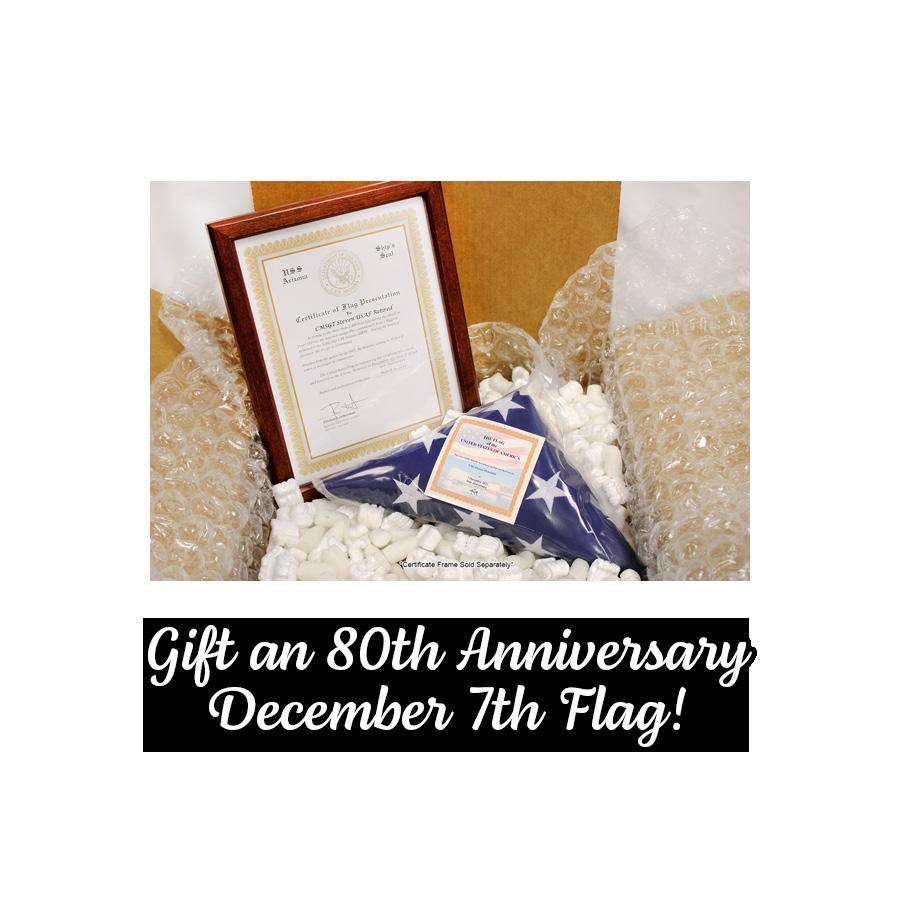
Please specify type: _________________________

Pacific Historic Parks may recognize my membership in The Legacy Society in its publications.
Createalegacythatwillensurehistorywillneverbeforgotten Name Address City, State, Zip Phone Email
Established in 1979, Pacific Historic Parks is a 501(c)(3), tax exempt cooperating association committed to preserving the legacy of our historic heritage by providing support of research, preservation, restoration, education and interpretive programs to the National Park Service at Pearl Harbor National Memorial (Pearl Harbor), War in the Pacific National Historical Park (Guam), American Memorial Park (Saipan), Kalaupapa National Historical Park (Molokai) and Diamond Head State Monument (Oahu).

Life Insurance
Life Income Gifts
WWW.PACIFICHISTORICPARKS.ORG 15
98-211 Pali Momi Street #200-A Aiea, Hawaii 96701

PRESORTED FIRST-CLASS MAIL U.S. POSTAGE PAID
PERMIT
985
HONOLULU, HI
NO.









































